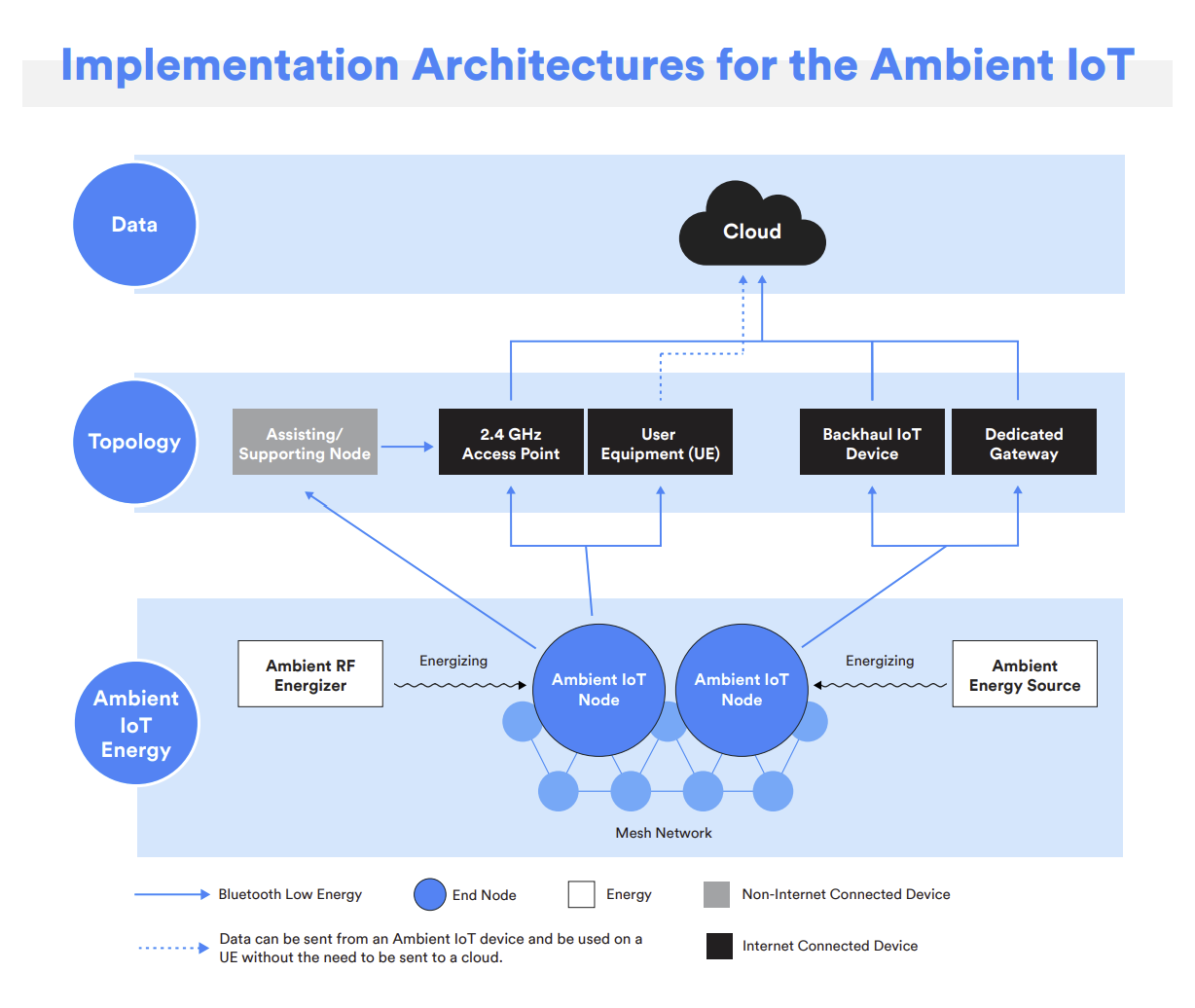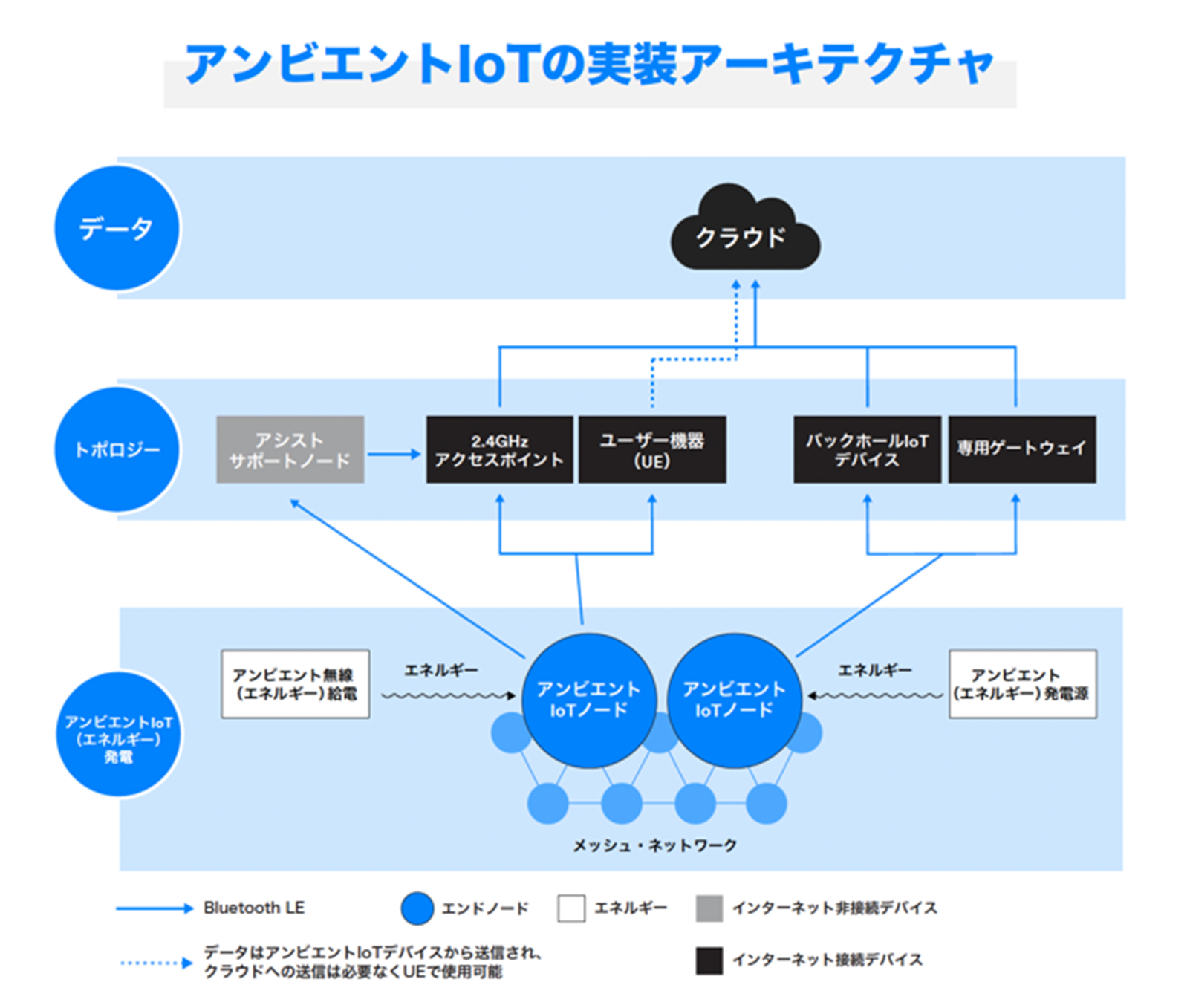The Role of Bluetooth Technology in the Ambient IoTアンビエントIoTでBluetooth技術が果たす役割
Over the past two years, the Ambient IoT has been a growing topic of discussion. Standards bodies have begun to explore how best they can support this new class of device and have been active in driving the conversation around this topic. Still, one of the difficulties with understanding the opportunities in this market is the lack of a standard definition of the Ambient IoT, such that it can engage companies from across the ecosystem.
Recently, the Bluetooth Special Interest Group (SIG) commissioned ABI Research – a global leader in analyzing, tracking, and forecasting the transformation of the smart device and IoT markets – to help define the Ambient IoT and examine the role of Bluetooth® technology plays in its evolution.
This research note – The Ambient IoT – The Emergence of a New Class of Bluetooth IoT Devices – establishes guidelines for comprehending the Ambient IoT, intending to align IoT ecosystem strategies to create Ambient IoT devices. It also evaluates the role of Bluetooth technology, notably Bluetooth® Low Energy (LE), in addressing Ambient IoT use cases. Bluetooth LE, as a low-power protocol, already has a central position in enabling this device class. It is the de facto choice for many IoT solution providers building applications based on ambient energy harvesting devices.
Where Bluetooth Technology Fits in the Ambient IoT
Bluetooth® technology…holds a central role in the evolution of the Ambient IoT.
Bluetooth® technology, and specifically Bluetooth LE, holds a central role in the evolution of the Ambient IoT. Reasons for this central role include the technology feature set of Bluetooth LE, which makes it a go-to technology for the Ambient IoT, and the Bluetooth SIG’s position within the ecosystem supporting the ongoing development of Bluetooth technology and creating a developer base for low-power IoT solutions.
For developers, Bluetooth LE offers the following benefits.
- Leading Low-Power Technology: Bluetooth LE is one of the lowest-power IoT protocols available today. It is often the first port of call for solution providers building use cases based on ambient energy harvesting, and many of the first Ambient IoT use cases rely on Bluetooth LE technology. As a result, Bluetooth LE’s lead in low-power technology plays a central role in enabling the new class of Ambient IoT devices, which rely on gathering tiny amounts of energy from ambient sources.
- Low Integrated Circuit (IC) Costs: Bluetooth chips are some of the most commoditized radios available for wireless markets, allowing developers to build low-cost devices. Unlike many other wireless protocols, system-on-chip (SoC) and system-in-package (SiP) development is very common with Bluetooth technology, allowing highly integrated, low-power, and low-cost solutions. The low cost of Bluetooth® chips, in relation to other connectivity technologies, gives Bluetooth technology an essential role in helping solution providers design and build Ambient IoT devices.
- Supports Flexible Topologies: Bluetooth LE supports multiple implementation topologies, including point-to-point, mesh, and broadcast. In addition, use cases with Bluetooth technology can be internet based, via a gateway, or peer-to-peer. Ambient IoT use cases may be implemented in many ways based on the targeted user and the environment in which a solution is deployed. Bluetooth LE, through its flexible topologies, plays an important role in enabling solution providers to develop Ambient IoT solutions in any way that best suits the use case and environment. The image below shows different implementation architectures for the Ambient IoT. Bluetooth LE can be used in all network topologies. It can also be used for both data transmission and energy harvesting.

Benefits of the Bluetooth Ecosystem
In addition to its technology strengths, Bluetooth® is a standard backed by the Bluetooth SIG with a large developer base. Advantages to developing within this ecosystem include:
![]()
- Long-Term Technology Support: Ambient IoT devices require long-life support in the field without maintenance or equipment replacement. With the sunsetting of 2G and 3G technologies, IoT adopters are increasingly forward thinking when selecting a technology that will permit longevity without replacing equipment. As an open and standard-backed technology, Bluetooth LE plays an important role in giving the confidence of long-term support to developers building Ambient IoT devices and customers adopting Ambient IoT use cases and devices.
- Feature Development: Ambient IoT devices perform many of the same functions as existing IoT devices — sensing, location, ID, and control. Bluetooth LE already includes features to address several of these requirements, such as multiple approaches to device positioning. The Bluetooth SIG is playing a role in further developing features that can support Ambient IoT use cases based on ongoing interaction with stakeholders across the Bluetooth® value chain; these features could involve harvesting energy from Bluetooth radio waves, radio frequency (RF)-based sensing, or data formats for different ID applications.
- Large Infrastructure Installed Base: For the Ambient IoT to be able to reach its full potential, it must be able to communicate with multiple types of infrastructure and equipment — such as dedicated or multi-use access points (APs) and gateways, user equipment (UE) like smartphones, or other forms of IoT devices. Bluetooth technology is widely accepted across multiple industries and has a large existing base of Bluetooth devices that creates a Bluetooth capable infrastructure. The ecosystem’s strength is an important reason why Bluetooth technology plays a central role in the Ambient IoT; it enables industrial, enterprise, and consumer markets to build use cases with minimal additional infrastructure, helping to lower the entry barriers of the Ambient IoT at scale.
- Interoperability and Scalability: Ambient IoT devices need to be easily deployed and maintained by users, whether for consumers or for enterprises. Interoperability may take different forms; some examples include cross-vendor implementations, implementations requiring multiple Ambient IoT device suppliers, or interoperability and easy provisioning with different UE or APs. The large ecosystem of solution providers using Bluetooth technology and its acceptance across industries allows customers to choose solutions based on their unique requirements while knowing that devices will simply work together. Supporting the development of the Ambient IoT, the Bluetooth SIG plays a role in facilitating the interoperability of Ambient IoT devices by adopting standards that eliminate the need for solution vendors to focus on proprietary solutions and eliminate the need for adopters to rely on a single solution provider.
The features and ecosystem of Bluetooth® technology are well evolved. As a result, solution providers and adopters can focus on innovation, such as form-factor designs, data management, and use cases targeting specific pain points rather than developing an entire technology stack from scratch. By further supporting the development of the Ambient IoT, Bluetooth technology can bring these existing features and ecosystem advantages to a new class of IoT devices, thereby providing long-term support and reliability to solution providers and technology adopters.
The Future for the IoT Ecosystem
Bluetooth® LE will play a central role in the evolution of the Ambient IoT.
The emergence of Ambient IoT devices represents a significant leap in the evolution of IoT devices, offering a promising future for the IoT ecosystem. By relying on ambient energy sources, the Ambient IoT enables the development of lower-cost, smaller form factor, and maintenance-free devices, thus opening new possibilities for IoT applications across various industries.
The market potential is extensive with early adoption focused on short-range wireless connectivity, particularly Bluetooth® LE technology. Bluetooth LE will play a central role in the evolution of the Ambient IoT. From a technology perspective, it is a leading, very low-power protocol that supports a wide range of network topologies and is available on many low-cost ICs. From an ecosystem perspective, Bluetooth® LE is an open, standard-backed technology that promises long-term support and feature evolution. Consequently, it has built a large developer base and a ubiquitous installed base of dedicated or multi-use infrastructure, facilitating further solutions built with the technology.
To learn more, read the full report: The Ambient IoT – The Emergence of a New Class of Bluetooth IoT Devices. This report helps define the Ambient IoT and outlines the role Bluetooth technology plays in its evolution.
過去2年の間に、アンビエントIoTの技術はより多く話題に上るようになりました。さまざまな標準化団体がアンビエントIoTをサポートする最適な方法を模索し始めたことで、この新しいクラスのデバイスに関する議論が活発化しています。しかしアンビエントIoTには、エコシステム全体を形づくる企業にとって共有可能な標準的定義がなく、そのことがアンビエントIoT市場におけるビジネスチャンスへの理解を阻む一因となっています。
先日Bluetooth SIG(Special Interest Group)は、アンビエントIoTがどのようなものであるかを明確にし、その進化の中でBluetooth®技術が果たす役割の精査を目的に、ABI Researchに調査を依頼しました。同社はスマートデバイスおよびIoT市場の変革に関する分析・追跡・予測分野の世界的トップ企業です。
この「アンビエントIoT:Bluetooth® IoTデバイスに新たなクラスが登場」調査レポートの目的は、アンビエントIoTを理解するためのガイドラインを確立し、アンビエントIoTデバイスを作り出すため、IoTエコシステム全体の戦略的な足並みをそろえることにあります。また、アンビエントIoTユースケースへの対応におけるBluetooth技術、特にBluetooth® Low Energy(LE)の役割について評価しています。Bluetooth LEは、低消費電力のプロトコルとして、アンビエントIoTの実現においてすでに中心的な存在となっており、IoTソリューションプロバイダーの多くが、環境発電デバイスをベースにしたアプリケーションを構築する上で実際の選択肢としています
Bluetooth技術がアンビエントIoTで果たす役割
Bluetooth®技術、とりわけBluetooth LEは、アンビエントIoTの進化において中心的な役割を果たしています。このような役割を担う理由として、Bluetooth LEの機能セットがアンビエントIoTに最適な技術であり、Bluetooth SIGがエコシステムにおいて、Bluetooth技術の継続的な開発をサポートし、低消費電力IoTソリューションの開発者基盤を構築していることが挙げられます。
開発者にとって、Bluetooth LEは次のようなメリットを提供します。
- 超低消費電力の最先端技術:Bluetooth LEは、現在利用可能なIoTプロトコルの中で、最も消費電力の低い技術のひとつです。ソリューションプロバイダーが環境発電を用いたユースケースを構築するにあたり、この技術が第一の選択肢とされる場合が多く、実際にアンビエントIoTのユースケースの多くはBluetooth LE技術を基盤としています。そのため、周囲のエネルギー源から回収される少量のエネルギーに依拠する新たなクラスのアンビエントIoTデバイスを実現する上で、低消費電力技術をリードするBluetooth LEは中心的な役割を担っています。
- 集積回路(IC)コストの低減:Bluetooth®チップは、ワイヤレス市場でもとりわけコモディティ化が進んだ無線デバイスで、開発企業による低コストでのデバイス構築を可能にします。他の多くのワイヤレスプロトコルとは異なり、BluetoothテクノロジーではSoC(system-on-chip)およびSiP(systemin-package)の開発が非常に一般的なため、高集積、低消費電力、低コストのソリューションが可能となります。Bluetoothチップは他の接続技術と比べて低コストなため、Bluetooth技術はソリューションプロバイダーによるアンビエントIoTデバイスの設計・構築に不可欠な役割を与えられています。
- 複数のトポロジーを柔軟にサポート:Bluetooth LEは、ポイントツーポイント、メッシュ、ブロードキャストなど、複数の実装トポロジーをサポートしています。さらにBluetooth技術は、インターネットベース、ゲートウェイ経由、ピアツーピアなどで使われています。アンビエントIoTのユースケースの実装は、ターゲットユーザーとソリューションが展開される環境に基づき、さまざまな方法に及ぶ可能性があります。複数のトポロジーを柔軟にサポートするBluetooth LEは、ソリューションプロバイダーがユースケースおよび環境にとって最適な方法でアンビエントIoTソリューションを開発する上で、重要な役割を果たします。下の図は、アンビエントIoTのいくつかの異なる実装アーキテクチャを示しています。Bluetooth LEはすべてのネットワークトポロジーで利用できるとともに、データ転送と環境発電の両方に活用できます。

Bluetoothエコシステムのメリット
Bluetooth®技術はその技術的な強みに加え、Bluetooth SIGによって支えられ、多数の開発企業が参入している標準規格です。このエコシステム内で開発を行うことは、次のような利点があります。
- 技術の長期的なサポート:アンビエントIoTデバイスは、保守や機器の交換を伴わずに現場での長期間のサポートが必要です。2Gや3G技術が終焉を迎えつつある中、IoTの導入者はこれまで以上に将来性を重視し、機器を交換せずに長期間の使用を実現できる技術を選択するようになっています。オープンかつ規格に支えられた技術であるBluetooth LEは、アンビエントIoTデバイスの開発企業やアンビエントIoTのユースケースやデバイスを導入する顧客に、長期的なサポートを得られるという安心と信頼感を与える上で重要な役割を果たします。
- 機能開発:アンビエントIoTデバイスでは、センシング、位置情報、ID、制御など、既存のIoTデバイスと同じさまざまな機能が実行されます。Bluetooth LEはすでに、デバイスの位置情報に関する複数のソリューションをはじめ、これらの要件のいくつかに対応する機能を備えています。Bluetooth SIGは、Bluetooth®バリューチェーン全体にわたる各関係者との継続的な対話に基づき、アンビエントIoTのユースケースをサポートする機能の開発を進める役割を担っています。開発される機能は、Bluetooth無線電波からの環境発電、無線周波数ベースのセンシング、さまざまなIDアプリケーションのためのデータ形式などが考えられます。
- 大規模インフラストラクチャを構築する基盤:アンビエントIoTの可能性を最大限に引き出すためには、専用・マルチユースのアクセスポイント(AP)、ゲートウェイ、スマートフォンなどのユーザー機器(UE)、その他の形態のIoTデバイスといった、さまざまなタイプのインフラストラクチャや機器と通信できる必要があります。Bluetooth技術はさまざまな業界で広く受け入れられており、大量の既存BluetoothデバイスによるBluetooth対応インフラストラクチャが構築されています。このエコシステムの強みは、産業、企業、消費者市場において、インフラストラクチャの追加を最小限に抑えながらユースケースを構築でき、大規模なアンビエントIoTの参入障壁を下げられる点にあり、Bluetooth技術がアンビエントIoTにおいて中心的な役割を果たす重要な理由となります。
- 相互運用性と拡張性:アンビエントIoTデバイスは、消費者向けであれ、企業向けであれ、ユーザーが容易に導入・保守できる必要があります。相互運用性の形式はさまざまあり、例えばクロスベンダーによる実装、複数のアンビエントIoTデバイスサプライヤーを必要とする実装、異なるUEやAPとの相互運用性および容易なプロビジョニングなどがあります。Bluetooth技術を使用するソリューションプロバイダーは大規模なエコシステムを構築しており、さまざまな業界から受け入れられています。これにより、顧客はデバイス同士がBluetoothで容易に連携することを認識しながら、独自の要件に基づいてソリューションを選択できます。アンビエントIoTの開発をサポートするため、Bluetooth SIGは、ソリューションベンダーから独自のソリューションを採用する必要性を取り除き、また導入者からは単一のソリューションプロバイダーに依存する必要をなくす標準規格を導入することで、アンビエントIoTデバイスの相互運用性を促進する役割を果たしています。
Bluetooth®技術の機能とエコシステムは進化しています。その結果、ソリューションプロバイダーや導入者は、フォームファクターの設計、データ管理、特定の弱点を対象としたユースケースなどのイノベーションに集中でき、技術スタック全体をゼロから開発せずに済みます。アンビエントIoTの開発をさらにサポートすることで、Bluetooth技術は既存の機能およびエコシステムの利点を、この新たなクラスのIoTデバイスにもたらすことができます。それにより、ソリューションプロバイダーと導入者に、長期的なサポートと信頼性を提供します。
IoTエコシステムの豊かな将来性
アンビエントIoTデバイスの登場はIoTデバイスにとって飛躍的な進化であり、IoTエコシステムの豊かな将来性を約束しています。環境エネルギーを使用することにより、アンビエントIoTはより低コストで小型、メンテナンスフリーのデバイスの開発を可能にし、さまざまな業界にまたがるIoTアプリケーションの新たな可能性の扉を開きます。
アンビエントIoT市場のポテンシャルは大きく、特にBluetooth® LE技術をはじめとする短距離無線接続では早期から採用が始まっており、市場は拡大を続けています。Bluetooth LEは、アンビエントIoTの進化において中心的な役割を果たします。Bluetooth LEは、技術面では最先端の超低消費電力プロトコルであり、幅広いネットワークトポロジーに対応し、多くの低コストICで利用できます。また、エコシステム面では、オープンかつ標準によって支えられた技術として、長期的なサポートと機能の進化が約束されています。そのため大規模な開発者ベースが存在し、専用あるいは複数用途のインフラストラクチャのいずれにおいてもインストール済みのデバイスが遍在しており、この技術を用いたソリューションの構築を強力に後押しします。
詳しくは、「アンビエントIoT:Bluetooth® IoTデバイスに新たなクラスが登場」のレポート本編をご覧ください。同レポートではアンビエントIoTがどのようなものであるかを解説し、その進化の中でBluetooth技術が果たす役割をまとめています。